Asus made it clear to us that this is a technology demo board – it is not a final product and still has some known (and presumably many unknown) bugs. As such, the numbers presented from our testing should be interpreted with caution.
Our article aims to provide an early insight into the type of performance that we can expect from the SATA Express interface.
Sequential read and write results from ATTO are well over the 700MB/s mark for both SATA Express implementations. Connected via native PCIe, the ROG RAIDR does seem to offer a marginal increase in performance, but as we have already pointed out, this is likely due to the SATA-E connector still undergoing finalisation.
Compared to a fast SSD capable of nearing the SATA 6Gbps interface's saturation point, SATA Express offers an average throughput increase of more than 39%. In comparison to the slightly higher-scoring external (ASMedia-fed) SATA Express interface, the average throughput increase over our test drive using SATA 6Gbps is 42%.
CrystalDiskMark's highly compressible data test (0x00, 0Fill) sees the RAIDR delivering around 700MB/s sequential read when connected via both SATA Express interfaces and the native PCIe slot. As we observed with Atto, native PCIe does seem to have a slight performance advantage, but this could be related to the relative immaturity of Asus's SATA Express implementation.
An increase in performance of over 30% can be obtained by switching from the saturated SATA 6Gbps interface to the SATA Express successor and a fast drive.
Quite clearly, SATA Express is currently limited by the speed of the drive that is connected. We haven't been able to say this about a storage subsystem in a while, but it actually looks like the connection interface can provide an excess of bandwidth (for current consumer SSDs, at least).
Worth pointing out is the discrepancy between 4K write results for the SATA Express interfaces compared to the native PCIe connection. After numerous reattempts with different driver, power, software, and connection combinations, we contacted Asus who looked into the issue and suggested that it is simply a bug related to the early SATA Express implementation. Given the relatively tight grouping of results that we have recorded throughout testing, we see no reason to disagree with Asus's suggestion.
HD Tune's read and write benchmarks show SATA Express managing to keep within a close margin of PCIe's performance figures.
As a result of the similar average transfer speeds, access time results were also closely matched between the three different connections.
Average access time for the 4kB random read test showed similar performance for each interface. A maximum recorded difference of around 6% is no cause for concern when taking the precision of HD Tune's test into account.
Average access time for the 4kB random write showed clear preference towards the RAIDR being used on a native PCIe connection. This mirrors the 4K write results presented by CrystalDiskMark. Compared to direct PCIe, increased latency for SATA Express could be understood; the data has to pass through additional controllers and/or the Z87 chipset.
But given that this is a technology demo board and SATA Express is still undergoing development and finalisation, it would be fair to guesstimate that the discrepancy is related to another early-release bug. We would be surprised if bugs such as this were still present upon official release of a retail product.
 KitGuru KitGuru.net – Tech News | Hardware News | Hardware Reviews | IOS | Mobile | Gaming | Graphics Cards
KitGuru KitGuru.net – Tech News | Hardware News | Hardware Reviews | IOS | Mobile | Gaming | Graphics Cards





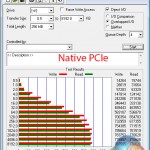


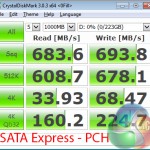
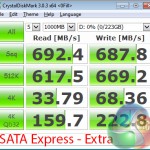




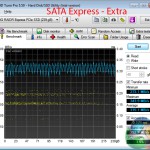



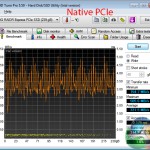



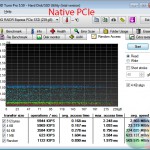


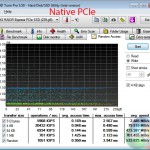

Great read there, looking forward to the next generation boards.
just devote a pcie slot to storage and just have pcie style SSD/HDD
I hope the new range of motherboards have this technology available, its a great idea. I use a lot of drives in RAID to get the max speed.
When are these going to be available?
That asus card takes up a lot of space, would be an issue with a system containing multiple GPU’s. the board looks great though, id be interesting in selling my current asus board and getting a new one this year if this gets adopted.
Fascinating read, spent the last hour on this article. thanks Kitguru.
The only issue will be the cost of adoption this year, the ASUS card is quite expensive still, although I see Amazon should have stock in soon.
I did enjoy the read, learned a few things as well, which is always good.